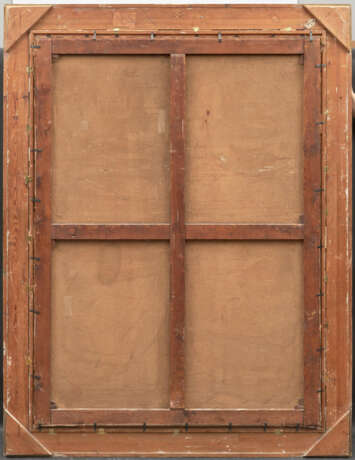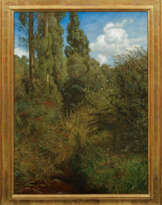ID 1424141
Lot 1262 | Romeo and Juliet
Estimate value
€ 8 000 – 12 000
Title: Romeo and Juliet.
Copy after Victor Müller.
Date: 1872.
Technique: Oil on canvas.
Measurement: 215 x 157cm.
Notation: Inscribed, monogrammed und dated at the bottom: "Dieses Bild habe ich von dem Bilde von Viktor Müller *1871 / im Auftrag Bruckmann München im Jahr 1872 gemalt - / beglaubigt - Karlsruhe 3.XI.1920. Hans Thoma".
Frame: Framed.
Cf. Literature:
A. Camion, S. Hurst (eds.): Les lettres parisiennes du peintre Victor Müller, Paris 2015, pp. 58-60;
E. Lehmann: Der Frankfurter Maler Victor Müller (1830-1871), Frankfurt 1976 (here with ill. of the original on p. 281, cat. rais. no. IV A 63).
Provenance:
Private ownership, Germany, since 1978.
"Wilt thou be gone? It is not yet near day," whispers the young woman to her beloved before he is banished. It is Romeo and Juliet's last encounter. The balcony scene takes place in front of Juliet's bedroom and is characterized by boundless devotion and deep tragedy at the same time, as both suspect that fate is tearing them apart. It is a particularly dramatic farewell, as the plot will develop in an even more tragic direction.
The present work by Hans Thoma is based on the painting "Romeo and Juliet" by Victor Müller (1830-1871). The work, which is now located in the Neue Pinakothek in Munich, was created by Müller around 1869/71 as one of 16 planned works in a monumental Shakespeare cycle commissioned from him by the Munich publisher Friedrich Bruckmann. In addition to this work, he also created the paintings "Hamlet and Horatio in the Churchyard" and "Ophelia" (both Städel Museum, Frankfurt). Due to Müller's early death, however, the commission remained unfinished.
Thoma met Müller during his last creative period in Munich, where Müller gathered a group of painters, from which the important Leibl Circle emerged later. These included Wilhelm Leibl, Otto Scholderer, Louis Eysen and Karl Haider. The slightly older Müller became Thoma's mentor and soon friend. Born in Frankfurt, he was a border crosser between Romanticism and Realism. His painting can be seen as a conciliatory attempt to respond to the aesthetic challenges of the incipient modern age. In the 1850s, he spent several years in Paris, which was on the rise artistically, worked among the artists of the Barbizon School and became friends with Gustave Courbet, whose realistic style of painting clearly influenced his work. At the same time, Müller was strongly rooted in Romanticism and loved to devote himself to literary subjects.
Shakespeare was a new discovery of Romanticism. His reception in the visual arts is coined by Eugène Delacroix's decades-long engagement with his poetry. These works were also known to Müller, who appreciated his work. In 1855, Müller exhibited at the Exposition universelle, where Delacroix's "Hamlet" and "Les adieux de Roméo et Juliette" were also shown.
About a month after Müller's death, Thoma was commissioned by Friedrich Bruckmann to produce a copy of his "Romeo and Juliet" as well as of the Hamlet painting in the same dimensions. In his copy, Thoma remained close to his friend's work. He succeeds in conveying the same intense inner emotion of the two lovers that Müller sought, but his work displays a looser brushstroke and the contours are more dissolved. After Thoma's rise to one of the most famous artists in Germany, he subsequently confirmed his authorship at the lower right in 1920, when he was already very old.
| Artist: | Hans Thoma (1839 - 1924) |
|---|---|
| Applied technique: | Oil |
| Auction house category: | Paintings by newer masters |
| Artist: | Hans Thoma (1839 - 1924) |
|---|---|
| Applied technique: | Oil |
| Auction house category: | Paintings by newer masters |
| Address of auction |
VAN HAM Kunstauktionen GmbH Hitzelerstr. 2 50968 Köln Germany | ||||||||||||||
|---|---|---|---|---|---|---|---|---|---|---|---|---|---|---|---|
| Preview | |||||||||||||||
| Phone | +49 221 92586215 | ||||||||||||||
| Fax | +49 221 92 58 62 4 | ||||||||||||||
| Buyer Premium | 32% | ||||||||||||||
| Conditions of purchase | Conditions of purchase | ||||||||||||||
| Business hours | Business hours
|














